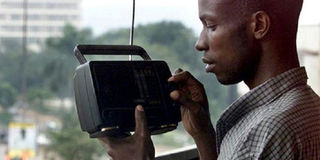Uganda imported 1.3m radios in five years

Most of the imports are portable radios, which are popular in rural areas. Photo | File
What you need to know:
- According to Ms Samantha Abaho, the Jumia public relations and social media manager, the most popular brands on the e-commerce site were Chinese brands - Hisense and Changhong.
Uganda imported at least 1.3 million radios between 2014 and 2018.
Data from Uganda Revenue Authority (URA) indicates that the country on average imports 268,187 radios per annum.
For instance, in 2014, 122,769 radios were imported while 270,656 were imported in 2015.
The number slightly increased to 288,343 in 2016 and 313,362 in 2017. In 2018 at least 345,808 radios were imported.
The Uganda Communications Commission (UCC) end-of life management of end user ICT draft report attributes the steady, yet dismal increase in importation, to incorporation of inbuilt radios in phones.
The imported radios, according the report, were mainly portable radios that are mostly used in rural areas, many of which have no access to electricity.
Presidential directive
However, in a matter of months, government will seek to procure 10 million radio sets and 137,466 solar-powered television sets for distribution to every household to facilitate home schooling.
However, the President has recently directed the Ministry of Finance to ensure that the radios and TVs are made in Uganda.
Currently, there are only two companies involved in assembling radios and televisions both of which are foreign owned.
“We have Saachi, which is based in Ntinda and Zhang Group in Bulogolobi, Kampala,” Mr Mubarak Kirunda Nkutu, the director of membership services at Uganda Manufacturers Association, told Daily Monitor, recently.
It remains unclear whether the companies have the capacity to assemble the products within the two-month timeline.
If the plants fail to hit the numbers, government could resort to imports, which would increase the country’s import bill thus taking away more foreign currency, which in turn will affect the shilling.
Matters on where the funds to acquire the radios and TVs will come from, however, remain blurry.
Relatedly, the country also imported 998,013 television sets in the five years since 2014 to 2018. Data shows that cathode ray tube televisions (CRT) are increasingly losing market as more people prefer liquid crystal display (LCD) and light emitting diodes (LED), commonly known as flat screens.
Only 306,468 ray tube television sects were imported compared to 691545 LCD and LED TVs in the period.
According to UCC, the decrease may be reflected in the phasing out of brand new CRT monitors on the market or an increase in life style purchase to flat screen monitors (LED and LCD TVs) as per the study findings, which have also reduced in purchase price.
Quality Vs pricing
According to Ms Samantha Abaho, the Jumia public relations and social media manager, the most popular brands on the e-commerce site were Chinese brands - Hisense and Changhong.
“The reason is they offer quality while still being affordable,” she says.
Hisense televisions on the Jumia site range from Shs430,000 and above while Changhong TVs cost Shs326,100 and above.
The report also indicates an increase in importation of computers and laptops over the years.




